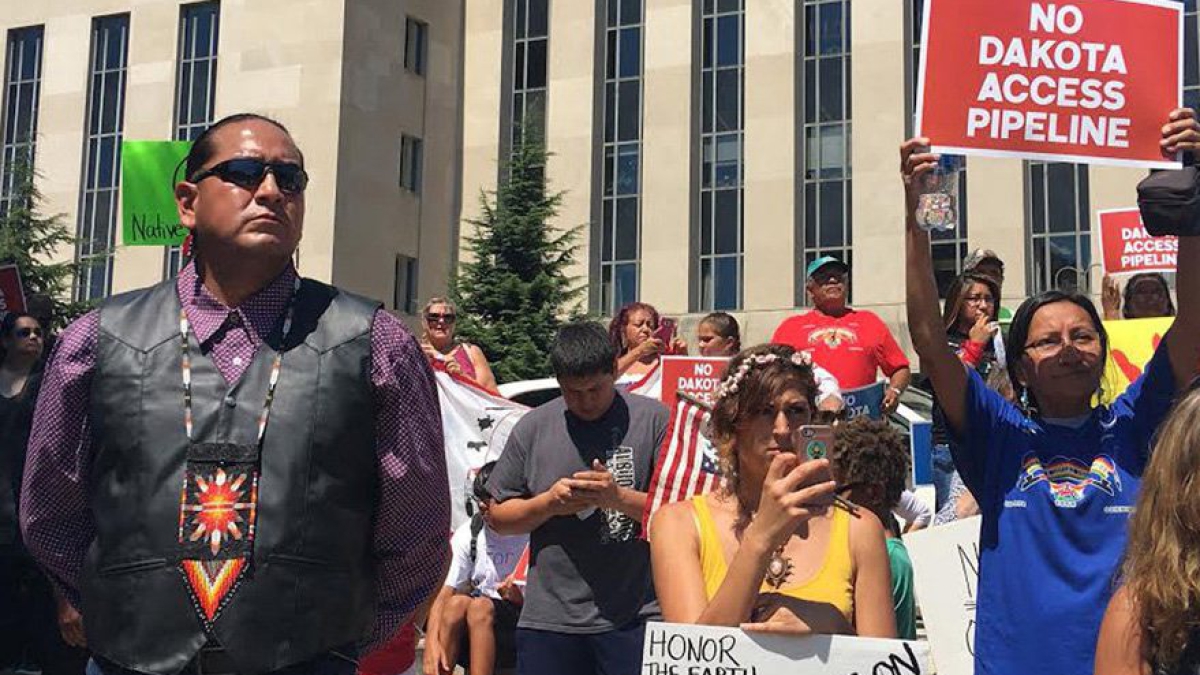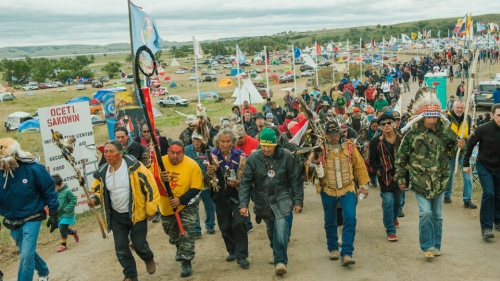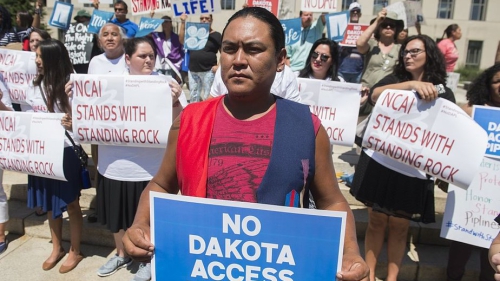The future cries out: 'Water is Life'

The dogs growl, the pepper spray bites, the bulldozers tear up the soil.
“Water is life!” they cry. “Water is life!”
This isn’t Flint, Michigan, but I feel the presence of its suffering in this cry of outrage at the Standing Rock Reservation in North Dakota. No more, no more. You will not poison our water or continue ravaging Planet Earth: mocking its sacredness, destroying its eco-diversity, reshaping and slowly killing it for profit.
The dogs growl, the pepper spray bites, the bulldozers tear up the soil and a judge rules against the Standing Rock Sioux Tribe’s demand that construction of the Dakota Access pipeline be stopped. Sorry, the wishes of the rich and powerful come first. And you protesters are just common criminals.
But sometimes the forces of corporate supremacy don’t get the final word. Something about this tribal-led protest could not be ignored, even by politicians. Initially, the permit application to build the 1,172-mile pipeline, from North Dakota to Illinois, had been fast-track through the federal bureaucracy. No matter that it would cut under the Missouri River or destroy ancestral burial grounds. Environmental and tribal concerns were not considered. The permit was granted and that was that. But shortly after the judge’s ruling upholding the permit, three branches of the Obama administration — the departments of Justice, the Interior and the Army — issued a joint statement temporarily suspending pipeline construction . . . and, good God, suggesting the intervention of a larger consciousness:
“. . . this case has highlighted the need for a serious discussion on whether there should be nationwide reform with respect to considering tribes’ views on these types of infrastructure projects.”
Water is life? And the feds give a damn?
As Rebecca Solnit wrote a few days later in The Guardian: “What’s happening at Standing Rock feels like a new civil rights movement” — one, she said, “that takes place at the confluence of environmental and human rights” awareness.
“Indigenous people have played a huge role, as (have) the people in many of the places where extracting and transporting fossil fuel take place, as protectors of particular places and ecosystems from rivers to forests, from the Amazon to the Arctic, as people with a strong sense of the past and the future, of the deep time in which short-term profit turns into long-term damage, and of the rights of the collective over individual profit. All these forces are antithetical to capitalism, and it to them.”
This extraordinary movement is also taking place at the confluence of the past and the future. David Archambault II, Standing Rock Sioux tribal chairman, put it this way recently in a New York Times op-ed: “As American citizens, we all have a responsibility to speak for a vision of the future that is safe and productive for our grandchildren.”
The world’s most powerful governmental bodies have demonstrated an alarming inability to do this on their own, beholden as they are to the military-industrial status quo and its need for endless growth. This is the maw of capitalism, which could care less about the future.
“We are also a resilient people who have survived unspeakable hardships in the past, so we know what is at stake now,” Archambault writes. “As our songs and prayers echo across the prairie, we need the public to see that in standing up for our rights, we do so on behalf of the millions of Americans who will be affected by this pipeline.
“As one of our greatest leaders, Chief Sitting Bull of the Hunkpapa Lakota, once said: ‘Let us put our minds together and see what life we can make for our children.’ That appeal is as relevant today as it was more than a century ago.”
As Winona LaDuke said of the Missouri River itself, this is a force to be reckoned with.
“Water is life!” they cry. “Water is life!”
“It is early evening, the moon full,” she writes. “If you close your eyes, you can remember the 50 million buffalo — the single largest migratory herd in the world. The pounding of their hooves would vibrate the Earth, make the grass grow.
“There were once 250 species of grass. Today the buffalo are gone, replaced by 28 million cattle, which require grain, water, and hay. Many of the fields are now in a single GMO crop, full of so many pesticides that the monarch butterflies are dying off. But in my memory, the old world remains.”
So the monarch is also part of the protest, part of the movement, with its drumbeat reverberating across the planet. The tribal peoples of Earth are making their voices heard in so many ways. Their mission is to reconnect the modern world with the circle of life — a circle that much of humanity left behind maybe ten millennia ago, in pursuit of the Agricultural Revolution and dominion over nature. In the process, we’ve succeeded in changing the climate and, perhaps, establishing a troubling new geological epoch. Now it’s time to rethink “progress.”
Building another pipeline is its antithesis.
******
Robert Koehler is an award-winning, Chicago-based journalist and nationally syndicated writer. Contact him at [email protected] or visit his website at commonwonders.com.
© 2016 TRIBUNE CONTENT AGENCY, INC.








